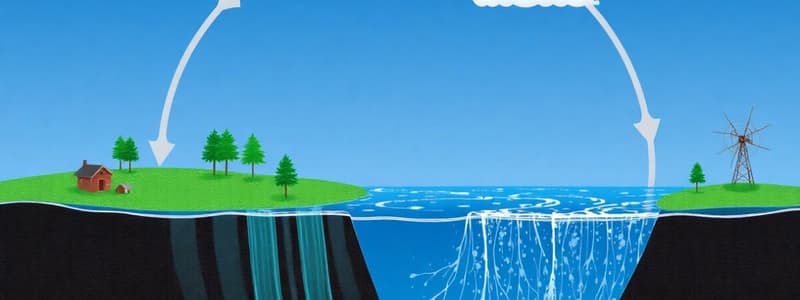Podcast
Questions and Answers
What is a misconception about the condensation process?
What is a misconception about the condensation process?
- Condensation only occurs at night.
- Rain itself is a form of condensation. (correct)
- Condensation increases atmospheric temperature.
- Condensation cannot occur without cooling.
What process in the water cycle involves water changing from a solid directly to a gas?
What process in the water cycle involves water changing from a solid directly to a gas?
- Sublimation (correct)
- Evaporation
- Transpiration
- Infiltration
Which process describes the movement of water from plants to the atmosphere?
Which process describes the movement of water from plants to the atmosphere?
- Infiltration
- Precipitation
- Transpiration (correct)
- Runoff
How does precipitation relate to condensation in the water cycle?
How does precipitation relate to condensation in the water cycle?
Which part of the water cycle is responsible for replenishing aquifers?
Which part of the water cycle is responsible for replenishing aquifers?
What phase transition primarily occurs during the process of evaporation in the water cycle?
What phase transition primarily occurs during the process of evaporation in the water cycle?
Which process directly contributes to the water vapor content in the atmosphere through plants?
Which process directly contributes to the water vapor content in the atmosphere through plants?
What is the primary driver that initiates the evaporation process in the water cycle?
What is the primary driver that initiates the evaporation process in the water cycle?
In which part of the water cycle does water change directly from a solid to a gaseous state?
In which part of the water cycle does water change directly from a solid to a gaseous state?
What is the term for water movement through the soil into the ground?
What is the term for water movement through the soil into the ground?
Flashcards
Evaporation
Evaporation
The process by which liquid water changes into water vapor in the atmosphere.
Condensation
Condensation
The transformation of water vapor in the atmosphere into liquid water droplets, forming clouds.
Precipitation
Precipitation
Any form of water that falls from the atmosphere to Earth's surface, including rain, snow, sleet, or hail.
Sublimation
Sublimation
Signup and view all the flashcards
Infiltration
Infiltration
Signup and view all the flashcards
Transpiration
Transpiration
Signup and view all the flashcards
Study Notes
The Water Cycle
- The water cycle, also known as the hydrologic cycle, describes the movement of water on, above, and below Earth's surface.
- Water constantly changes states (solid ice, liquid water, gaseous water vapor) within the cycle.
- The hydrosphere encompasses all Earth's water in all states near its surface. It includes surface water (rivers, lakes, oceans), groundwater, and atmospheric water vapor.
- Earth's water supply is finite; no new water is created; it's recycled.
Main Parts of the Water Cycle
- Evaporation: Liquid water is heated, turning into water vapor. The sun is the primary heat source.
- Condensation: Water vapor cools and changes back into a liquid. This can happen due to saturation (the air cannot hold any more vapor) or cooling (vapor reaching its dew point).
- Precipitation: Water returns to Earth's surface as rain, snow, sleet, or hail.
Additional Processes in the Water Cycle
- Sublimation: Direct transition from ice to water vapor (skipping the liquid phase). Important in snow's contribution to the atmosphere.
- Transpiration: Evaporation of water from plant leaves.
- Runoff: Water flows over the land's surface due to gravity.
- Infiltration: Water soaks into the ground, replenishing groundwater.
Importance of the Water Cycle
- Crucial for life on Earth because it sustains all life forms.
- Accounts for roughly 1% of readily available water on Earth.
- Closely linked to Earth's climate, influencing weather patterns, ecosystems, and geography.
Studying That Suits You
Use AI to generate personalized quizzes and flashcards to suit your learning preferences.




